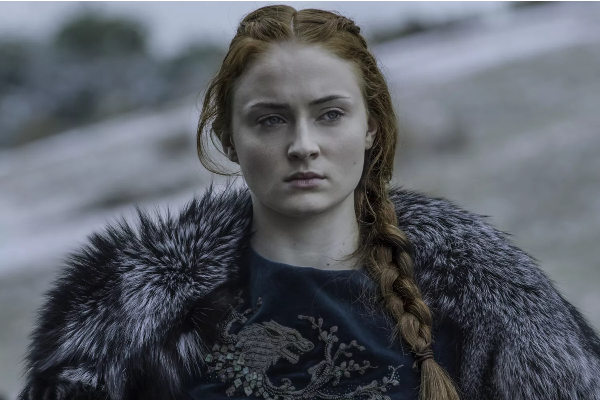Movies
Sophie Turner’s Steadfast Defense: Why Sansa Stark’s Rape Scene in Game of Thrones Remains a Crucible for Conversation
1. A Calculated Confrontation: The Rape Scene That Sparked Debate
Sophie Turner has once again revisited one of the most controversial and emotionally charged moments in Game of Thrones—the infamous scene in which Sansa Stark is brutally raped by Ramsay Bolton in Season 5. Speaking in a reflective interview, Sophie Turner defended the moment, explaining that while disturbing, it was a deliberate choice by the creators meant to shine a light on systemic violence against women.
For many viewers, the scene in the episode “Unbowed, Unbent, Unbroken” was almost unwatchable. Sansa, a character who had already endured years of cruelty, is stripped of her agency and subjected to trauma on her wedding night while her childhood companion Theon is forced to bear witness. The decision to place such an event at the center of her storyline was shocking not only because of its brutality, but because it marked a departure from George R. R. Martin’s novels.
Yet Sophie Turner stood firm in her belief that the sequence carried weight beyond shock value. She described it as an unflinching portrayal of “the fight women have had to fight for hundreds of thousands of years—the patriarchy, being treated as objects, and being constantly assaulted.” For her, the scene was not exploitative but revealing, an acknowledgment of the violence that has defined women’s historical reality.

2. Art as Reckoning: The Role of Television in Making Hard Truths Visible
Television, at its most powerful, can serve as a mirror to history’s darkest truths, and Sophie Turner believes Game of Thrones fulfilled that role. She admitted that if the show aired today, producers would almost certainly include trigger warnings. But in her eyes, the raw nature of the scene was part of its purpose. To sanitize it, she argued, would have been dishonest to the world the series was portraying—a brutal, medieval-inspired realm where power was often asserted through physical and sexual violence.
It is important to recognize that the showrunners took creative liberties in adapting the story. In Martin’s A Dance with Dragons, Sansa never marries Ramsay; instead, another character, Jeyne Poole, suffers his abuse. The series shifted the narrative, placing Sansa in the center of the ordeal, ensuring that the trauma would have profound implications for a character deeply beloved by fans.
Critics of the adaptation questioned whether this change was necessary or respectful, but the show’s writers insisted it was consistent with the brutal logic of their universe. “If Sansa marries Ramsay, what happens on their wedding night?” asked Bryan Cogman, one of the producers. “The answer was obvious, however disturbing.”
Sophie Turner has echoed this sentiment, explaining that the scene was not about shock but about acknowledging a reality. In doing so, the show forced audiences to confront something deeply uncomfortable: the normalization of sexual violence in both fictional and historical contexts.
3. A Flashpoint for Viewers and Critics: The Response Was Fierce—and Divided
When the episode aired in 2015, the response was immediate and explosive. Sophie Turner media erupted with outrage. Some fans vowed never to watch the series again. A United States senator even announced he was boycotting the show. The backlash was so fierce that the controversy became a cultural flashpoint, sparking larger debates about television’s responsibility when depicting rape and trauma.
Critics were split into two camps. Detractors argued that the scene was gratuitous, undermining Sansa’s growth as a character by reducing her to a victim yet again. They accused the show of shock tactics, pointing out a pattern of escalating violence and sexual assault across the series. Some argued that the writers had robbed Sansa of agency just as she seemed to be stepping into her own power.
Supporters, however, contended that the moment was harrowing precisely because it involved such a central character. Unlike one-off victims or side characters, Sansa’s trauma was guaranteed to resonate throughout the rest of the series. This, they argued, prevented the scene from being dismissed as cheap exploitation. Publications like Rolling Stone and The Guardian highlighted Sophie Turner’s haunting performance, noting that the scene was filmed with restraint and an emphasis on emotional impact rather than lurid detail.
Even George R. R. Martin weighed in, defending the show’s choice by reminding critics that rape has historically been a weapon of war. To exclude or minimize it, he argued, would have been historically dishonest.
This division among critics and audiences revealed the heart of the debate: was the scene an exploitative attempt at shock, or was it a necessary, if brutal, reflection of reality? The answer depends on one’s philosophy of art—should fiction shield us from harsh truths, or should it hold them up like a mirror?
4. Sansa’s Evolution: Strategy, Resilience, and Reclamation of Power
For Sophie Turner, the true importance of the scene lies not in the moment itself, but in how Sansa responds in the episodes that follow. While some fans wished she had fought back immediately, Sophie Turner explained that Sansa’s strength was not in brute force but in her resilience, her ability to endure and outthink her enemies.
At a fan panel, Sophie Turner said, “She could have fought back. But she didn’t. She does her scheming in her mind.” This was not passivity, but strategy. By surviving Ramsay’s cruelty, Sansa learned patience, cunning, and control—the very qualities that would later allow her to reclaim Winterfell and declare herself Queen in the North.
This arc reframed the rape scene not as a permanent defeat, but as a crucible that forged Sansa into one of the series’ most formidable leaders. Unlike earlier versions of her character, who often dreamed of fairy-tale romances and political marriages, Sansa emerged hardened, pragmatic, and fiercely protective of her people.
It is this transformation that Sophie Turner remains most proud of. “It was about a hardened woman making a choice,” Bryan Cogman said. “And she becomes stronger because of it.” While such framing risks romanticizing trauma, Turner insisted that Sansa’s resilience was the narrative point. It was not about erasing her pain, but about showing how she used it to reclaim her agency.
5. Beyond Fiction: How One Scene Fueled Activism and Real-World Dialogue
For Sophie Turner, the controversy surrounding the scene did not remain confined to the world of Westeros. It became a turning point in her personal life, pushing her toward advocacy and activism.
In 2017, she wrote about the experience, confessing that she was struck by how much outrage the fictional assault generated compared to the relative silence surrounding real-world sexual violence. Why, she asked, were audiences more enraged by a television episode than by atrocities happening globally? That question inspired her to become more vocal in raising awareness.
Turner later partnered with Women for Women International, becoming a patron of the organization. Through her involvement, she traveled to Rwanda to meet survivors of the 1994 genocide, many of whom had endured systematic sexual violence. Listening to their stories deepened her understanding of resilience, survival, and the importance of bringing such conversations into the public eye.
By channeling the controversy into activism, Turner transformed what could have been a purely negative moment into a platform for advocacy. She used her visibility not only to defend a fictional scene but to demand recognition for real survivors whose voices are often silenced.
From: Doublejoydesigns
